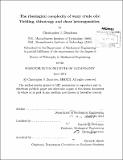The rheological complexity of waxy crude oils : yielding, thixotropy and shear heterogeneities
Author(s)
Dimitriou, Christopher (Christopher J.)
DownloadFull printable version (32.68Mb)
Other Contributors
Massachusetts Institute of Technology. Department of Mechanical Engineering.
Advisor
Gareth H. McKinley.
Terms of use
Metadata
Show full item recordAbstract
Precipitate-containing crude oils are of increasing economic importance, due to diminishing oil reserves and the increased need to extract hydrate and wax-containing crude oil from ultra deep-water resources. Despite this need, the rheological behavior of these types of crude oil is often poorly understood. In this thesis, we investigate some of the underlying complexities associated with the rheology of waxy crude oils. These complex phenomena are often difficult to both quantify experimentally and capture with existing constitutive models. The contribution of this thesis is therefore to develop a detailed understanding of three of these particular phenomena, through the development and use of several new experimental and theoretical tools. A better understanding of waxy crude oil rheology is critical for developing flow assurance strategies, which can in turn ensure continuous production of precipitate-containing crude oils under adverse conditions. The three phenomena studied are, first: shear heterogeneities, i.e. the manifestation of wall slip, shear banding or other shear-localization events under imposed deformations that are assumed to be homogenous. For these purposes, flow visualization techniques capable of "Rheo-PIV" measurements are developed to detect these heterogeneities. Second: elasto-viscoplasticity, or the presence of an elastic response and a yield-like behavior in a non-Newtonian fluid. Constitutive modeling of this type of behavior is difficult to achieve using standard linear viscoelastic techniques, where the viscoelastic response is decomposed into a finite number of linear elements with a spectrum of relaxation times. For these reasons, additional concepts are adopted from plasticity models in order to describe this behavior. Finally: thixotropy, which refers to the ability of a fluid to continuously evolve, or age at rest and shear rejuvenate under a constant applied shear rate. A rigorous set of experimental tests is constructed which allow for the appropriate constitutive model parameters to be determined for a thixotropic fluid. Through quantitative study of these phenomena, we reach several conclusions about how to characterize and model the rheology of a precipitate-containing crude oil. First, measurements of shear heterogeneities are important in these fluids, so that rheological characterization may proceed with a knowledge of when these may arise and introduce artifacts into data. Second, new nonlinear rheometric techniques are necessary to develop quantitative data sets that describe the inherently nonlinear rheology of these fluids. The specific technique developed in this work is termed stress-controlled large amplitude oscillatory shear, or LAOStress. Finally, we show that the constitutive behavior of these materials is best prescribed using a framework which utilizes yielding and hardening mechanisms from plasticity theory. The resulting constitutive model for this nonlinear elasto-viscoplastic and thixotropic class of materials is expressed in a closed form that can be used in existing flow assurance simulation tools. The most relevant applications for this work are in the flow assurance challenges associated with crude oil production. Consequently, a large portion of the experimental work is carried out on a model waxy crude oil, containing a total wax content ranging from 5 to 10% by weight. However the phenomena studied here occur ubiquitously in a number of complex fluids. For this reason, the same rheological complexities are studied in the context of several other fluids, including a swollen microgel paste (Carbopol) and a shear-banding wormlike micellar solution.
Description
Thesis (Ph. D.)--Massachusetts Institute of Technology, Dept. of Mechanical Engineering, 2013. Cataloged from PDF version of thesis. Includes bibliographical references (p. 305-320).
Date issued
2013Department
Massachusetts Institute of Technology. Department of Mechanical EngineeringPublisher
Massachusetts Institute of Technology
Keywords
Mechanical Engineering.